Financial Performance Analysis: AA and Aggreko Companies Trends
VerifiedAdded on 2020/04/21
|7
|3166
|81
Report
AI Summary
This report presents a comprehensive financial analysis of two companies, AA and Aggreko, from 2012 to 2016. The analysis begins with an examination of historical revenue, profitability, and balance sheet items, highlighting fluctuations and trends in each company's performance. Part 1 delves into the financial statements of AA and Aggreko, focusing on revenue, profit, non-current liabilities, equity, and cash flow. The analysis also includes a detailed examination of financial ratios, including profitability, liquidity, gearing, activity, and shareholder ratios, and their trends over the five-year period. An inter-company comparison of financial ratios is also conducted for the year 2016. The report aims to provide a clear understanding of the financial health and performance of both companies, identifying strengths, weaknesses, and areas of concern based on the financial data and ratios presented. It provides an in-depth look at profitability, liquidity, gearing, activity, and shareholder ratios, along with their trends over the years. The report concludes with an inter-company comparison for the year 2016 to highlight the relative financial performance of AA and Aggreko.
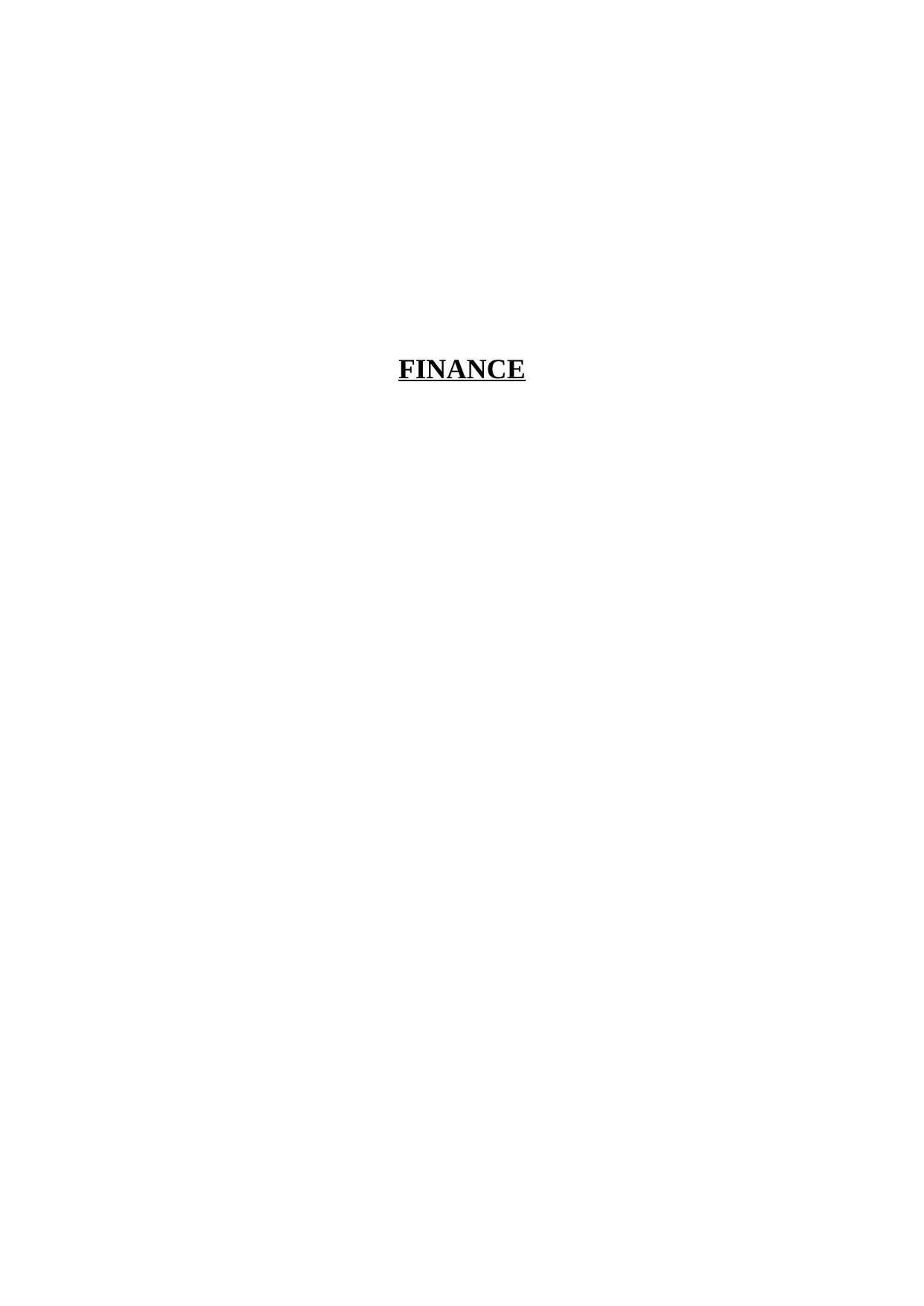
FINANCE
Secure Best Marks with AI Grader
Need help grading? Try our AI Grader for instant feedback on your assignments.
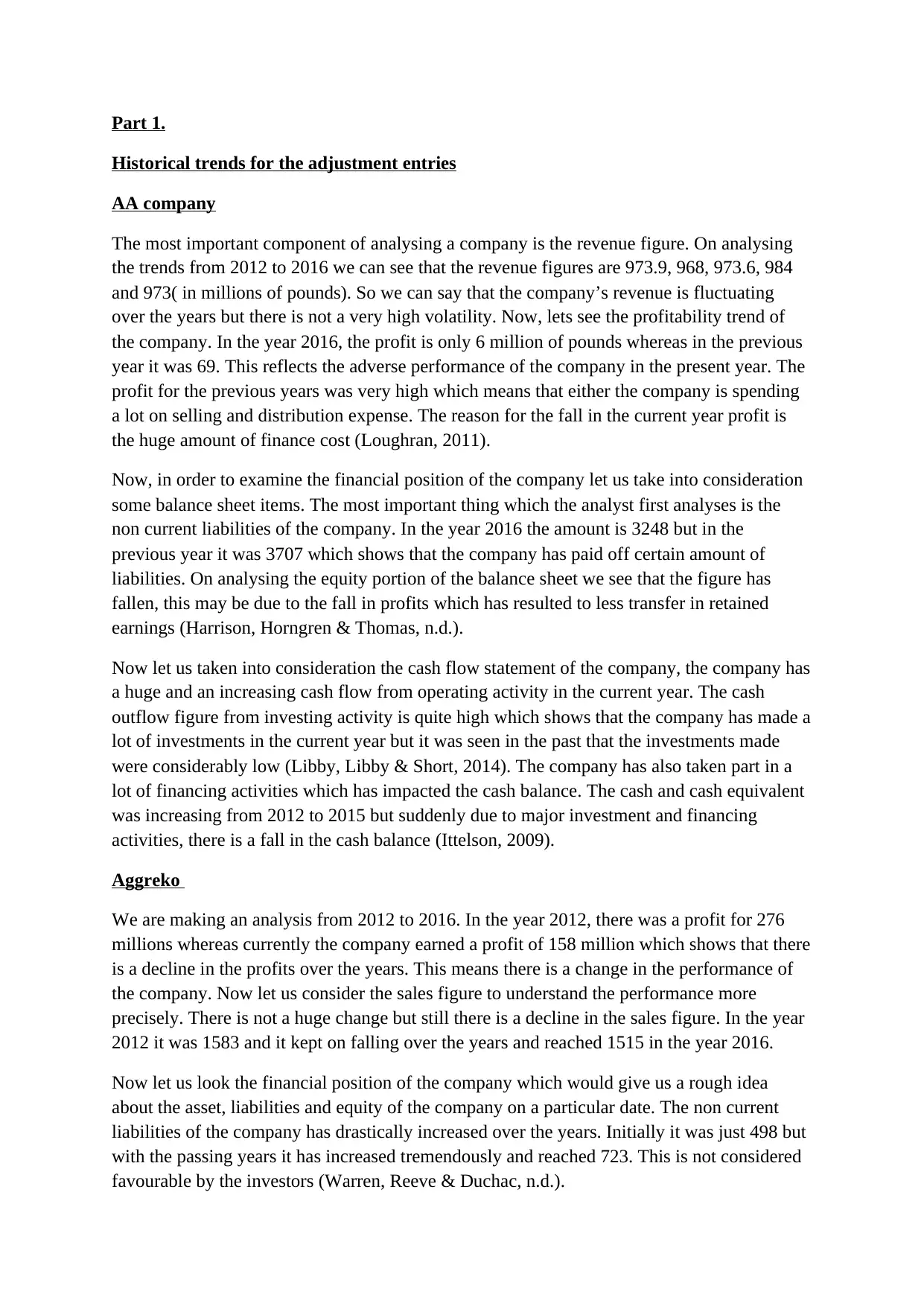
Part 1.
Historical trends for the adjustment entries
AA company
The most important component of analysing a company is the revenue figure. On analysing
the trends from 2012 to 2016 we can see that the revenue figures are 973.9, 968, 973.6, 984
and 973( in millions of pounds). So we can say that the company’s revenue is fluctuating
over the years but there is not a very high volatility. Now, lets see the profitability trend of
the company. In the year 2016, the profit is only 6 million of pounds whereas in the previous
year it was 69. This reflects the adverse performance of the company in the present year. The
profit for the previous years was very high which means that either the company is spending
a lot on selling and distribution expense. The reason for the fall in the current year profit is
the huge amount of finance cost (Loughran, 2011).
Now, in order to examine the financial position of the company let us take into consideration
some balance sheet items. The most important thing which the analyst first analyses is the
non current liabilities of the company. In the year 2016 the amount is 3248 but in the
previous year it was 3707 which shows that the company has paid off certain amount of
liabilities. On analysing the equity portion of the balance sheet we see that the figure has
fallen, this may be due to the fall in profits which has resulted to less transfer in retained
earnings (Harrison, Horngren & Thomas, n.d.).
Now let us taken into consideration the cash flow statement of the company, the company has
a huge and an increasing cash flow from operating activity in the current year. The cash
outflow figure from investing activity is quite high which shows that the company has made a
lot of investments in the current year but it was seen in the past that the investments made
were considerably low (Libby, Libby & Short, 2014). The company has also taken part in a
lot of financing activities which has impacted the cash balance. The cash and cash equivalent
was increasing from 2012 to 2015 but suddenly due to major investment and financing
activities, there is a fall in the cash balance (Ittelson, 2009).
Aggreko
We are making an analysis from 2012 to 2016. In the year 2012, there was a profit for 276
millions whereas currently the company earned a profit of 158 million which shows that there
is a decline in the profits over the years. This means there is a change in the performance of
the company. Now let us consider the sales figure to understand the performance more
precisely. There is not a huge change but still there is a decline in the sales figure. In the year
2012 it was 1583 and it kept on falling over the years and reached 1515 in the year 2016.
Now let us look the financial position of the company which would give us a rough idea
about the asset, liabilities and equity of the company on a particular date. The non current
liabilities of the company has drastically increased over the years. Initially it was just 498 but
with the passing years it has increased tremendously and reached 723. This is not considered
favourable by the investors (Warren, Reeve & Duchac, n.d.).
Historical trends for the adjustment entries
AA company
The most important component of analysing a company is the revenue figure. On analysing
the trends from 2012 to 2016 we can see that the revenue figures are 973.9, 968, 973.6, 984
and 973( in millions of pounds). So we can say that the company’s revenue is fluctuating
over the years but there is not a very high volatility. Now, lets see the profitability trend of
the company. In the year 2016, the profit is only 6 million of pounds whereas in the previous
year it was 69. This reflects the adverse performance of the company in the present year. The
profit for the previous years was very high which means that either the company is spending
a lot on selling and distribution expense. The reason for the fall in the current year profit is
the huge amount of finance cost (Loughran, 2011).
Now, in order to examine the financial position of the company let us take into consideration
some balance sheet items. The most important thing which the analyst first analyses is the
non current liabilities of the company. In the year 2016 the amount is 3248 but in the
previous year it was 3707 which shows that the company has paid off certain amount of
liabilities. On analysing the equity portion of the balance sheet we see that the figure has
fallen, this may be due to the fall in profits which has resulted to less transfer in retained
earnings (Harrison, Horngren & Thomas, n.d.).
Now let us taken into consideration the cash flow statement of the company, the company has
a huge and an increasing cash flow from operating activity in the current year. The cash
outflow figure from investing activity is quite high which shows that the company has made a
lot of investments in the current year but it was seen in the past that the investments made
were considerably low (Libby, Libby & Short, 2014). The company has also taken part in a
lot of financing activities which has impacted the cash balance. The cash and cash equivalent
was increasing from 2012 to 2015 but suddenly due to major investment and financing
activities, there is a fall in the cash balance (Ittelson, 2009).
Aggreko
We are making an analysis from 2012 to 2016. In the year 2012, there was a profit for 276
millions whereas currently the company earned a profit of 158 million which shows that there
is a decline in the profits over the years. This means there is a change in the performance of
the company. Now let us consider the sales figure to understand the performance more
precisely. There is not a huge change but still there is a decline in the sales figure. In the year
2012 it was 1583 and it kept on falling over the years and reached 1515 in the year 2016.
Now let us look the financial position of the company which would give us a rough idea
about the asset, liabilities and equity of the company on a particular date. The non current
liabilities of the company has drastically increased over the years. Initially it was just 498 but
with the passing years it has increased tremendously and reached 723. This is not considered
favourable by the investors (Warren, Reeve & Duchac, n.d.).
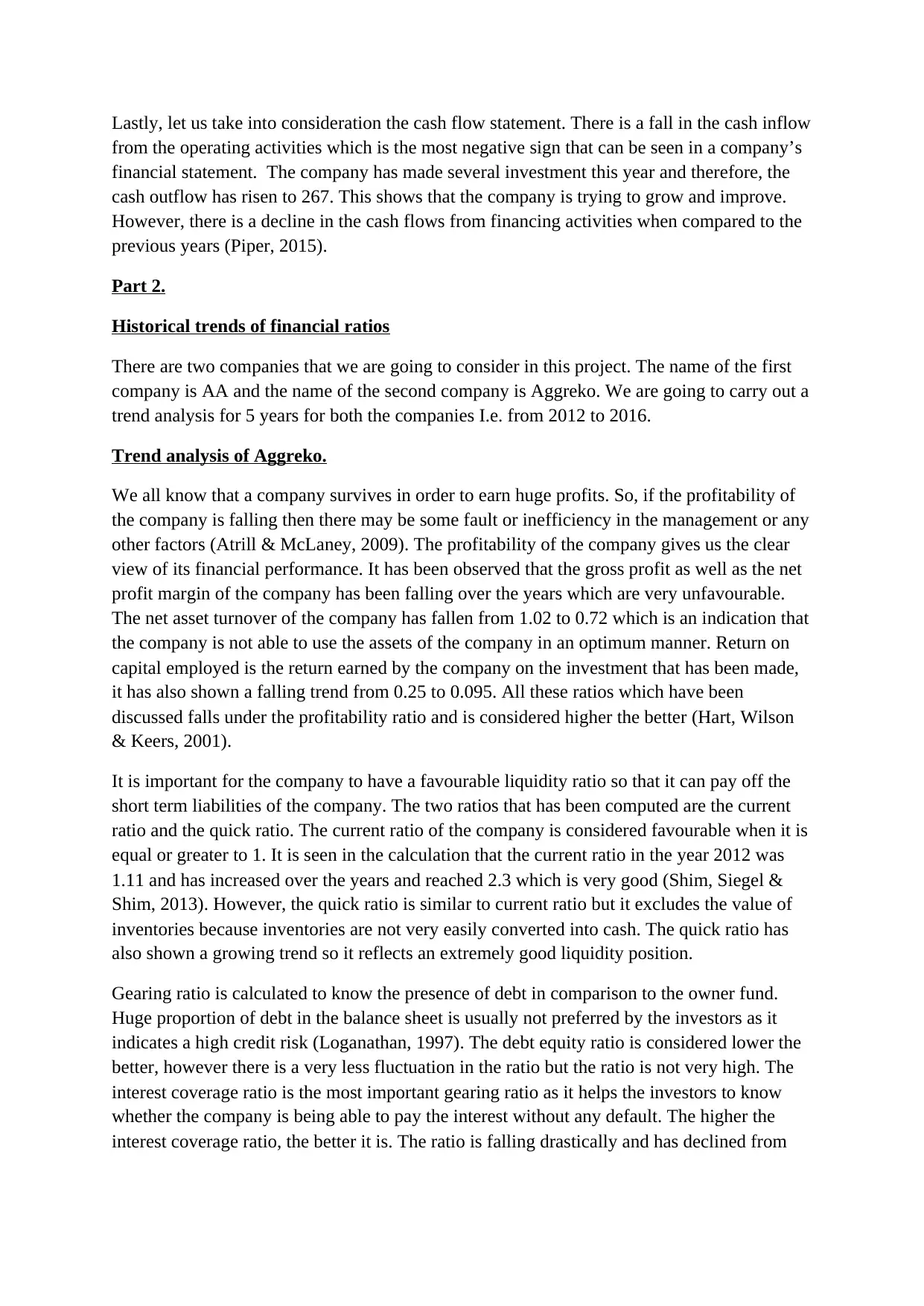
Lastly, let us take into consideration the cash flow statement. There is a fall in the cash inflow
from the operating activities which is the most negative sign that can be seen in a company’s
financial statement. The company has made several investment this year and therefore, the
cash outflow has risen to 267. This shows that the company is trying to grow and improve.
However, there is a decline in the cash flows from financing activities when compared to the
previous years (Piper, 2015).
Part 2.
Historical trends of financial ratios
There are two companies that we are going to consider in this project. The name of the first
company is AA and the name of the second company is Aggreko. We are going to carry out a
trend analysis for 5 years for both the companies I.e. from 2012 to 2016.
Trend analysis of Aggreko.
We all know that a company survives in order to earn huge profits. So, if the profitability of
the company is falling then there may be some fault or inefficiency in the management or any
other factors (Atrill & McLaney, 2009). The profitability of the company gives us the clear
view of its financial performance. It has been observed that the gross profit as well as the net
profit margin of the company has been falling over the years which are very unfavourable.
The net asset turnover of the company has fallen from 1.02 to 0.72 which is an indication that
the company is not able to use the assets of the company in an optimum manner. Return on
capital employed is the return earned by the company on the investment that has been made,
it has also shown a falling trend from 0.25 to 0.095. All these ratios which have been
discussed falls under the profitability ratio and is considered higher the better (Hart, Wilson
& Keers, 2001).
It is important for the company to have a favourable liquidity ratio so that it can pay off the
short term liabilities of the company. The two ratios that has been computed are the current
ratio and the quick ratio. The current ratio of the company is considered favourable when it is
equal or greater to 1. It is seen in the calculation that the current ratio in the year 2012 was
1.11 and has increased over the years and reached 2.3 which is very good (Shim, Siegel &
Shim, 2013). However, the quick ratio is similar to current ratio but it excludes the value of
inventories because inventories are not very easily converted into cash. The quick ratio has
also shown a growing trend so it reflects an extremely good liquidity position.
Gearing ratio is calculated to know the presence of debt in comparison to the owner fund.
Huge proportion of debt in the balance sheet is usually not preferred by the investors as it
indicates a high credit risk (Loganathan, 1997). The debt equity ratio is considered lower the
better, however there is a very less fluctuation in the ratio but the ratio is not very high. The
interest coverage ratio is the most important gearing ratio as it helps the investors to know
whether the company is being able to pay the interest without any default. The higher the
interest coverage ratio, the better it is. The ratio is falling drastically and has declined from
from the operating activities which is the most negative sign that can be seen in a company’s
financial statement. The company has made several investment this year and therefore, the
cash outflow has risen to 267. This shows that the company is trying to grow and improve.
However, there is a decline in the cash flows from financing activities when compared to the
previous years (Piper, 2015).
Part 2.
Historical trends of financial ratios
There are two companies that we are going to consider in this project. The name of the first
company is AA and the name of the second company is Aggreko. We are going to carry out a
trend analysis for 5 years for both the companies I.e. from 2012 to 2016.
Trend analysis of Aggreko.
We all know that a company survives in order to earn huge profits. So, if the profitability of
the company is falling then there may be some fault or inefficiency in the management or any
other factors (Atrill & McLaney, 2009). The profitability of the company gives us the clear
view of its financial performance. It has been observed that the gross profit as well as the net
profit margin of the company has been falling over the years which are very unfavourable.
The net asset turnover of the company has fallen from 1.02 to 0.72 which is an indication that
the company is not able to use the assets of the company in an optimum manner. Return on
capital employed is the return earned by the company on the investment that has been made,
it has also shown a falling trend from 0.25 to 0.095. All these ratios which have been
discussed falls under the profitability ratio and is considered higher the better (Hart, Wilson
& Keers, 2001).
It is important for the company to have a favourable liquidity ratio so that it can pay off the
short term liabilities of the company. The two ratios that has been computed are the current
ratio and the quick ratio. The current ratio of the company is considered favourable when it is
equal or greater to 1. It is seen in the calculation that the current ratio in the year 2012 was
1.11 and has increased over the years and reached 2.3 which is very good (Shim, Siegel &
Shim, 2013). However, the quick ratio is similar to current ratio but it excludes the value of
inventories because inventories are not very easily converted into cash. The quick ratio has
also shown a growing trend so it reflects an extremely good liquidity position.
Gearing ratio is calculated to know the presence of debt in comparison to the owner fund.
Huge proportion of debt in the balance sheet is usually not preferred by the investors as it
indicates a high credit risk (Loganathan, 1997). The debt equity ratio is considered lower the
better, however there is a very less fluctuation in the ratio but the ratio is not very high. The
interest coverage ratio is the most important gearing ratio as it helps the investors to know
whether the company is being able to pay the interest without any default. The higher the
interest coverage ratio, the better it is. The ratio is falling drastically and has declined from
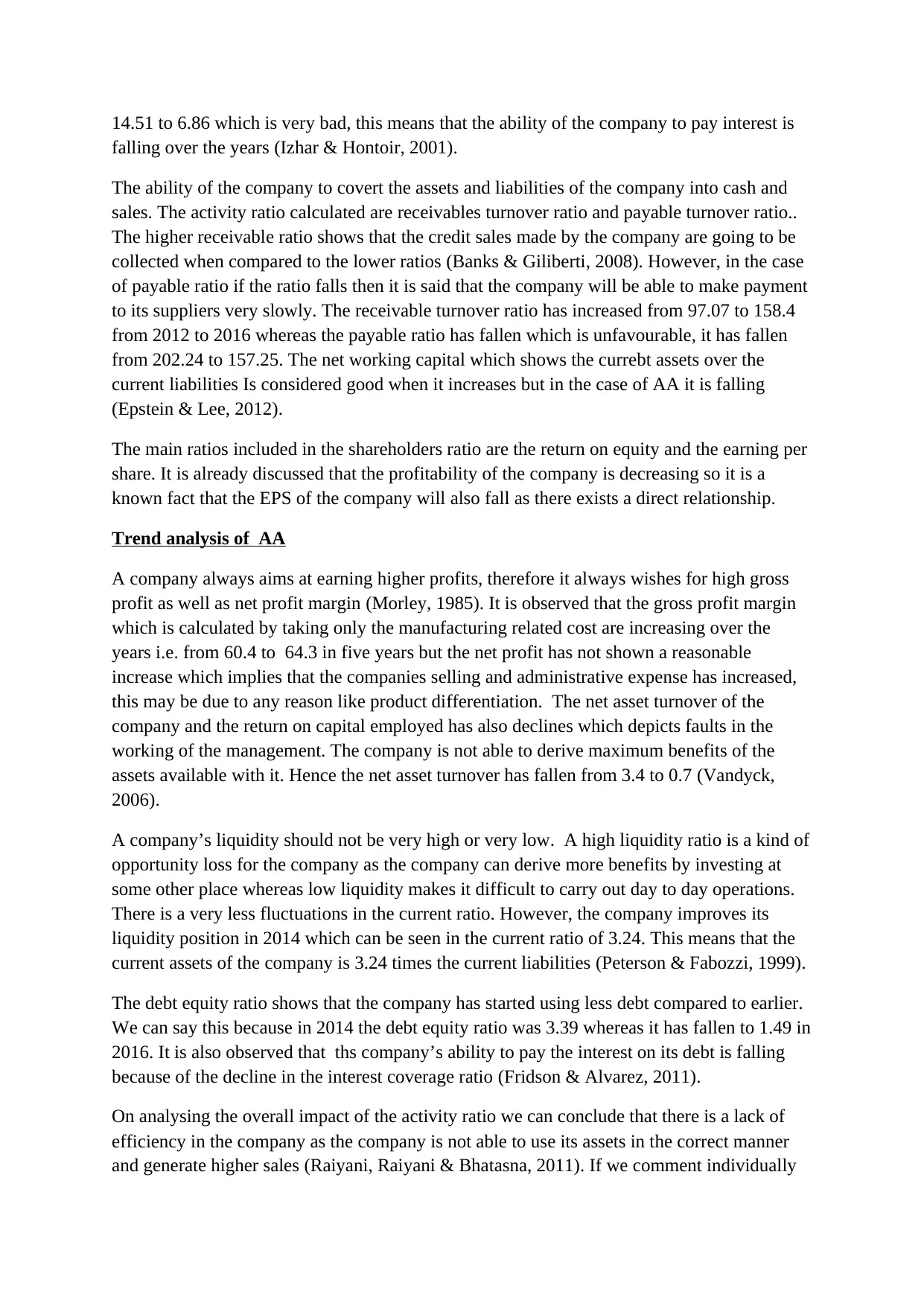
14.51 to 6.86 which is very bad, this means that the ability of the company to pay interest is
falling over the years (Izhar & Hontoir, 2001).
The ability of the company to covert the assets and liabilities of the company into cash and
sales. The activity ratio calculated are receivables turnover ratio and payable turnover ratio..
The higher receivable ratio shows that the credit sales made by the company are going to be
collected when compared to the lower ratios (Banks & Giliberti, 2008). However, in the case
of payable ratio if the ratio falls then it is said that the company will be able to make payment
to its suppliers very slowly. The receivable turnover ratio has increased from 97.07 to 158.4
from 2012 to 2016 whereas the payable ratio has fallen which is unfavourable, it has fallen
from 202.24 to 157.25. The net working capital which shows the currebt assets over the
current liabilities Is considered good when it increases but in the case of AA it is falling
(Epstein & Lee, 2012).
The main ratios included in the shareholders ratio are the return on equity and the earning per
share. It is already discussed that the profitability of the company is decreasing so it is a
known fact that the EPS of the company will also fall as there exists a direct relationship.
Trend analysis of AA
A company always aims at earning higher profits, therefore it always wishes for high gross
profit as well as net profit margin (Morley, 1985). It is observed that the gross profit margin
which is calculated by taking only the manufacturing related cost are increasing over the
years i.e. from 60.4 to 64.3 in five years but the net profit has not shown a reasonable
increase which implies that the companies selling and administrative expense has increased,
this may be due to any reason like product differentiation. The net asset turnover of the
company and the return on capital employed has also declines which depicts faults in the
working of the management. The company is not able to derive maximum benefits of the
assets available with it. Hence the net asset turnover has fallen from 3.4 to 0.7 (Vandyck,
2006).
A company’s liquidity should not be very high or very low. A high liquidity ratio is a kind of
opportunity loss for the company as the company can derive more benefits by investing at
some other place whereas low liquidity makes it difficult to carry out day to day operations.
There is a very less fluctuations in the current ratio. However, the company improves its
liquidity position in 2014 which can be seen in the current ratio of 3.24. This means that the
current assets of the company is 3.24 times the current liabilities (Peterson & Fabozzi, 1999).
The debt equity ratio shows that the company has started using less debt compared to earlier.
We can say this because in 2014 the debt equity ratio was 3.39 whereas it has fallen to 1.49 in
2016. It is also observed that ths company’s ability to pay the interest on its debt is falling
because of the decline in the interest coverage ratio (Fridson & Alvarez, 2011).
On analysing the overall impact of the activity ratio we can conclude that there is a lack of
efficiency in the company as the company is not able to use its assets in the correct manner
and generate higher sales (Raiyani, Raiyani & Bhatasna, 2011). If we comment individually
falling over the years (Izhar & Hontoir, 2001).
The ability of the company to covert the assets and liabilities of the company into cash and
sales. The activity ratio calculated are receivables turnover ratio and payable turnover ratio..
The higher receivable ratio shows that the credit sales made by the company are going to be
collected when compared to the lower ratios (Banks & Giliberti, 2008). However, in the case
of payable ratio if the ratio falls then it is said that the company will be able to make payment
to its suppliers very slowly. The receivable turnover ratio has increased from 97.07 to 158.4
from 2012 to 2016 whereas the payable ratio has fallen which is unfavourable, it has fallen
from 202.24 to 157.25. The net working capital which shows the currebt assets over the
current liabilities Is considered good when it increases but in the case of AA it is falling
(Epstein & Lee, 2012).
The main ratios included in the shareholders ratio are the return on equity and the earning per
share. It is already discussed that the profitability of the company is decreasing so it is a
known fact that the EPS of the company will also fall as there exists a direct relationship.
Trend analysis of AA
A company always aims at earning higher profits, therefore it always wishes for high gross
profit as well as net profit margin (Morley, 1985). It is observed that the gross profit margin
which is calculated by taking only the manufacturing related cost are increasing over the
years i.e. from 60.4 to 64.3 in five years but the net profit has not shown a reasonable
increase which implies that the companies selling and administrative expense has increased,
this may be due to any reason like product differentiation. The net asset turnover of the
company and the return on capital employed has also declines which depicts faults in the
working of the management. The company is not able to derive maximum benefits of the
assets available with it. Hence the net asset turnover has fallen from 3.4 to 0.7 (Vandyck,
2006).
A company’s liquidity should not be very high or very low. A high liquidity ratio is a kind of
opportunity loss for the company as the company can derive more benefits by investing at
some other place whereas low liquidity makes it difficult to carry out day to day operations.
There is a very less fluctuations in the current ratio. However, the company improves its
liquidity position in 2014 which can be seen in the current ratio of 3.24. This means that the
current assets of the company is 3.24 times the current liabilities (Peterson & Fabozzi, 1999).
The debt equity ratio shows that the company has started using less debt compared to earlier.
We can say this because in 2014 the debt equity ratio was 3.39 whereas it has fallen to 1.49 in
2016. It is also observed that ths company’s ability to pay the interest on its debt is falling
because of the decline in the interest coverage ratio (Fridson & Alvarez, 2011).
On analysing the overall impact of the activity ratio we can conclude that there is a lack of
efficiency in the company as the company is not able to use its assets in the correct manner
and generate higher sales (Raiyani, Raiyani & Bhatasna, 2011). If we comment individually
Secure Best Marks with AI Grader
Need help grading? Try our AI Grader for instant feedback on your assignments.
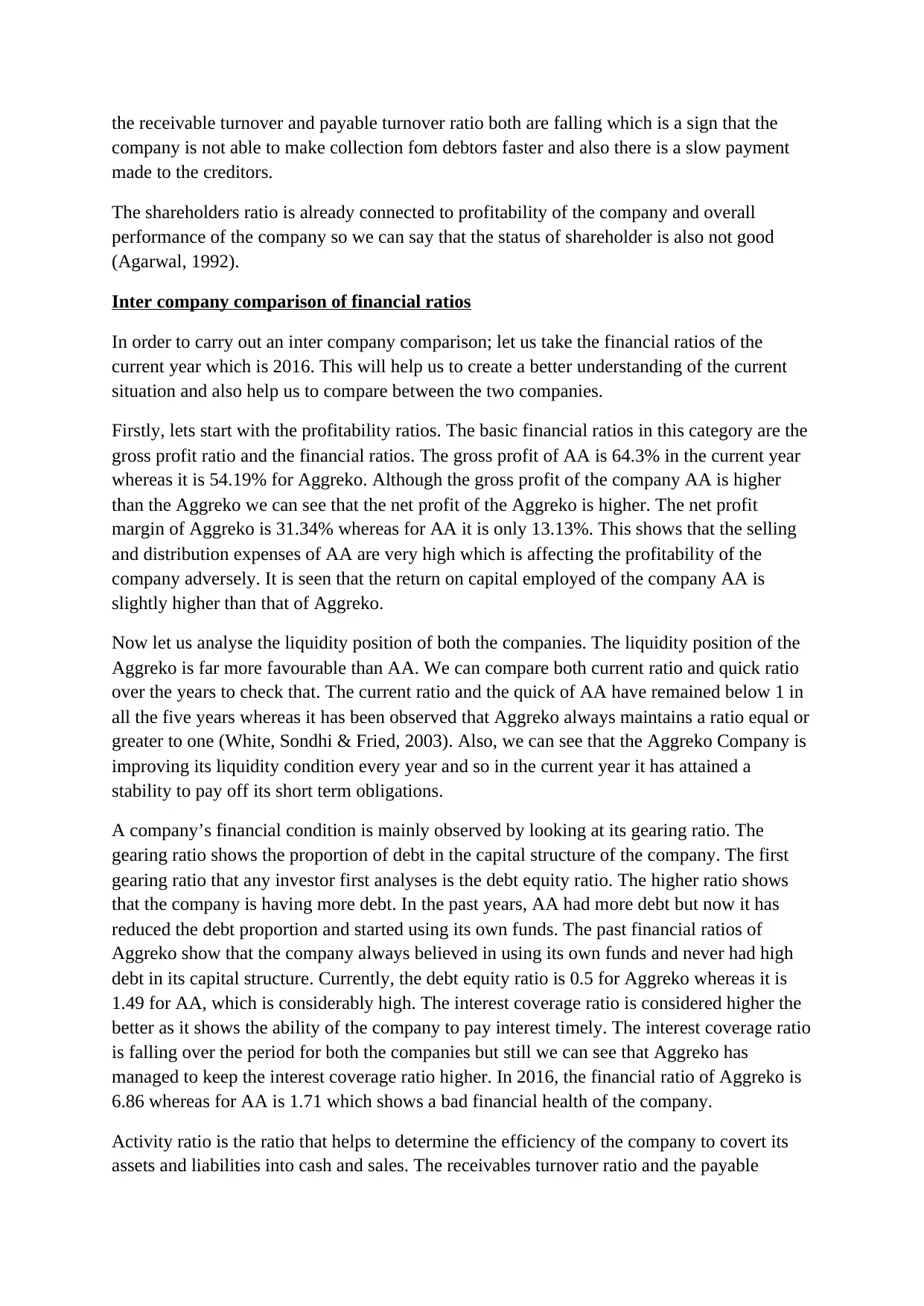
the receivable turnover and payable turnover ratio both are falling which is a sign that the
company is not able to make collection fom debtors faster and also there is a slow payment
made to the creditors.
The shareholders ratio is already connected to profitability of the company and overall
performance of the company so we can say that the status of shareholder is also not good
(Agarwal, 1992).
Inter company comparison of financial ratios
In order to carry out an inter company comparison; let us take the financial ratios of the
current year which is 2016. This will help us to create a better understanding of the current
situation and also help us to compare between the two companies.
Firstly, lets start with the profitability ratios. The basic financial ratios in this category are the
gross profit ratio and the financial ratios. The gross profit of AA is 64.3% in the current year
whereas it is 54.19% for Aggreko. Although the gross profit of the company AA is higher
than the Aggreko we can see that the net profit of the Aggreko is higher. The net profit
margin of Aggreko is 31.34% whereas for AA it is only 13.13%. This shows that the selling
and distribution expenses of AA are very high which is affecting the profitability of the
company adversely. It is seen that the return on capital employed of the company AA is
slightly higher than that of Aggreko.
Now let us analyse the liquidity position of both the companies. The liquidity position of the
Aggreko is far more favourable than AA. We can compare both current ratio and quick ratio
over the years to check that. The current ratio and the quick of AA have remained below 1 in
all the five years whereas it has been observed that Aggreko always maintains a ratio equal or
greater to one (White, Sondhi & Fried, 2003). Also, we can see that the Aggreko Company is
improving its liquidity condition every year and so in the current year it has attained a
stability to pay off its short term obligations.
A company’s financial condition is mainly observed by looking at its gearing ratio. The
gearing ratio shows the proportion of debt in the capital structure of the company. The first
gearing ratio that any investor first analyses is the debt equity ratio. The higher ratio shows
that the company is having more debt. In the past years, AA had more debt but now it has
reduced the debt proportion and started using its own funds. The past financial ratios of
Aggreko show that the company always believed in using its own funds and never had high
debt in its capital structure. Currently, the debt equity ratio is 0.5 for Aggreko whereas it is
1.49 for AA, which is considerably high. The interest coverage ratio is considered higher the
better as it shows the ability of the company to pay interest timely. The interest coverage ratio
is falling over the period for both the companies but still we can see that Aggreko has
managed to keep the interest coverage ratio higher. In 2016, the financial ratio of Aggreko is
6.86 whereas for AA is 1.71 which shows a bad financial health of the company.
Activity ratio is the ratio that helps to determine the efficiency of the company to covert its
assets and liabilities into cash and sales. The receivables turnover ratio and the payable
company is not able to make collection fom debtors faster and also there is a slow payment
made to the creditors.
The shareholders ratio is already connected to profitability of the company and overall
performance of the company so we can say that the status of shareholder is also not good
(Agarwal, 1992).
Inter company comparison of financial ratios
In order to carry out an inter company comparison; let us take the financial ratios of the
current year which is 2016. This will help us to create a better understanding of the current
situation and also help us to compare between the two companies.
Firstly, lets start with the profitability ratios. The basic financial ratios in this category are the
gross profit ratio and the financial ratios. The gross profit of AA is 64.3% in the current year
whereas it is 54.19% for Aggreko. Although the gross profit of the company AA is higher
than the Aggreko we can see that the net profit of the Aggreko is higher. The net profit
margin of Aggreko is 31.34% whereas for AA it is only 13.13%. This shows that the selling
and distribution expenses of AA are very high which is affecting the profitability of the
company adversely. It is seen that the return on capital employed of the company AA is
slightly higher than that of Aggreko.
Now let us analyse the liquidity position of both the companies. The liquidity position of the
Aggreko is far more favourable than AA. We can compare both current ratio and quick ratio
over the years to check that. The current ratio and the quick of AA have remained below 1 in
all the five years whereas it has been observed that Aggreko always maintains a ratio equal or
greater to one (White, Sondhi & Fried, 2003). Also, we can see that the Aggreko Company is
improving its liquidity condition every year and so in the current year it has attained a
stability to pay off its short term obligations.
A company’s financial condition is mainly observed by looking at its gearing ratio. The
gearing ratio shows the proportion of debt in the capital structure of the company. The first
gearing ratio that any investor first analyses is the debt equity ratio. The higher ratio shows
that the company is having more debt. In the past years, AA had more debt but now it has
reduced the debt proportion and started using its own funds. The past financial ratios of
Aggreko show that the company always believed in using its own funds and never had high
debt in its capital structure. Currently, the debt equity ratio is 0.5 for Aggreko whereas it is
1.49 for AA, which is considerably high. The interest coverage ratio is considered higher the
better as it shows the ability of the company to pay interest timely. The interest coverage ratio
is falling over the period for both the companies but still we can see that Aggreko has
managed to keep the interest coverage ratio higher. In 2016, the financial ratio of Aggreko is
6.86 whereas for AA is 1.71 which shows a bad financial health of the company.
Activity ratio is the ratio that helps to determine the efficiency of the company to covert its
assets and liabilities into cash and sales. The receivables turnover ratio and the payable
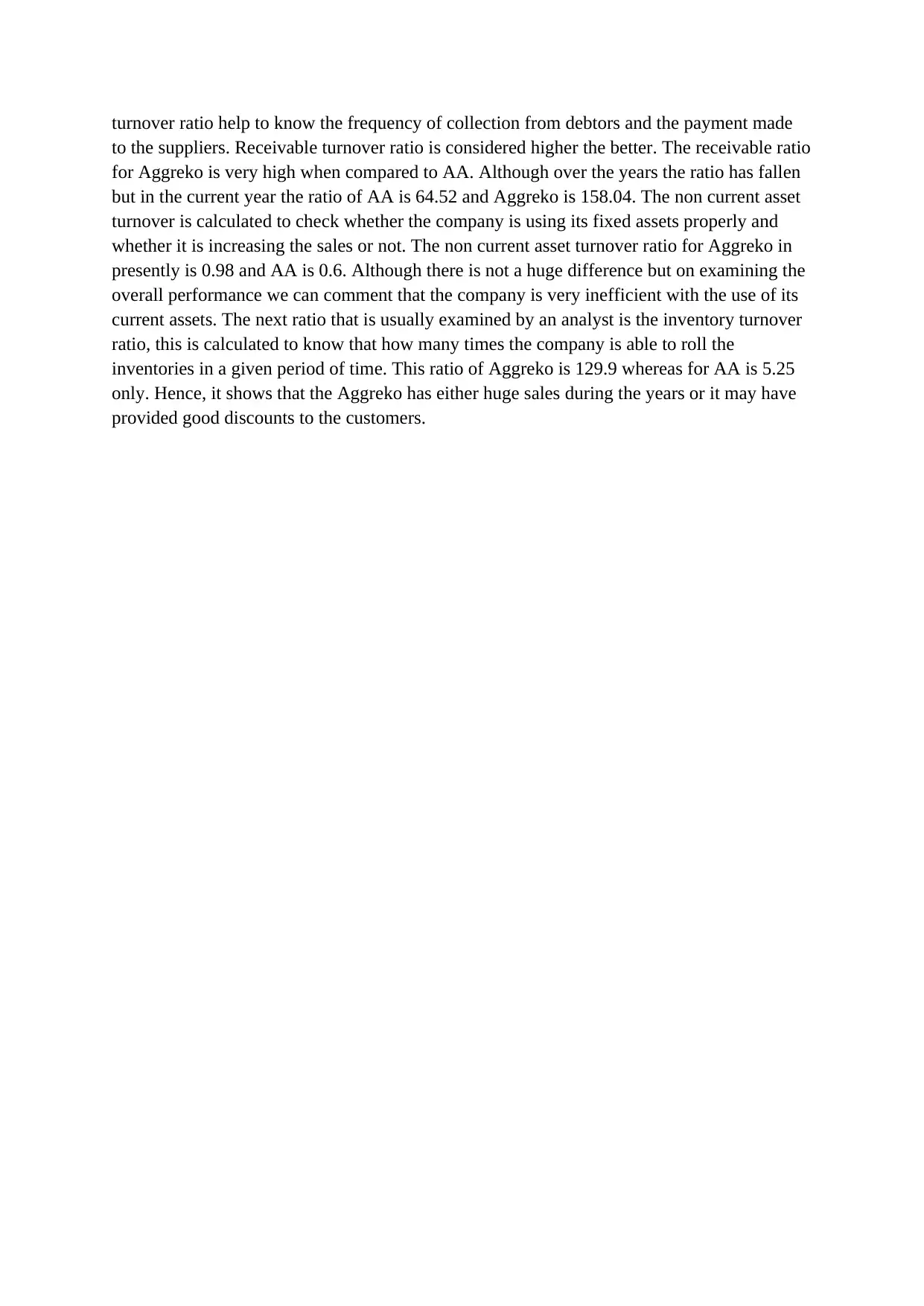
turnover ratio help to know the frequency of collection from debtors and the payment made
to the suppliers. Receivable turnover ratio is considered higher the better. The receivable ratio
for Aggreko is very high when compared to AA. Although over the years the ratio has fallen
but in the current year the ratio of AA is 64.52 and Aggreko is 158.04. The non current asset
turnover is calculated to check whether the company is using its fixed assets properly and
whether it is increasing the sales or not. The non current asset turnover ratio for Aggreko in
presently is 0.98 and AA is 0.6. Although there is not a huge difference but on examining the
overall performance we can comment that the company is very inefficient with the use of its
current assets. The next ratio that is usually examined by an analyst is the inventory turnover
ratio, this is calculated to know that how many times the company is able to roll the
inventories in a given period of time. This ratio of Aggreko is 129.9 whereas for AA is 5.25
only. Hence, it shows that the Aggreko has either huge sales during the years or it may have
provided good discounts to the customers.
to the suppliers. Receivable turnover ratio is considered higher the better. The receivable ratio
for Aggreko is very high when compared to AA. Although over the years the ratio has fallen
but in the current year the ratio of AA is 64.52 and Aggreko is 158.04. The non current asset
turnover is calculated to check whether the company is using its fixed assets properly and
whether it is increasing the sales or not. The non current asset turnover ratio for Aggreko in
presently is 0.98 and AA is 0.6. Although there is not a huge difference but on examining the
overall performance we can comment that the company is very inefficient with the use of its
current assets. The next ratio that is usually examined by an analyst is the inventory turnover
ratio, this is calculated to know that how many times the company is able to roll the
inventories in a given period of time. This ratio of Aggreko is 129.9 whereas for AA is 5.25
only. Hence, it shows that the Aggreko has either huge sales during the years or it may have
provided good discounts to the customers.
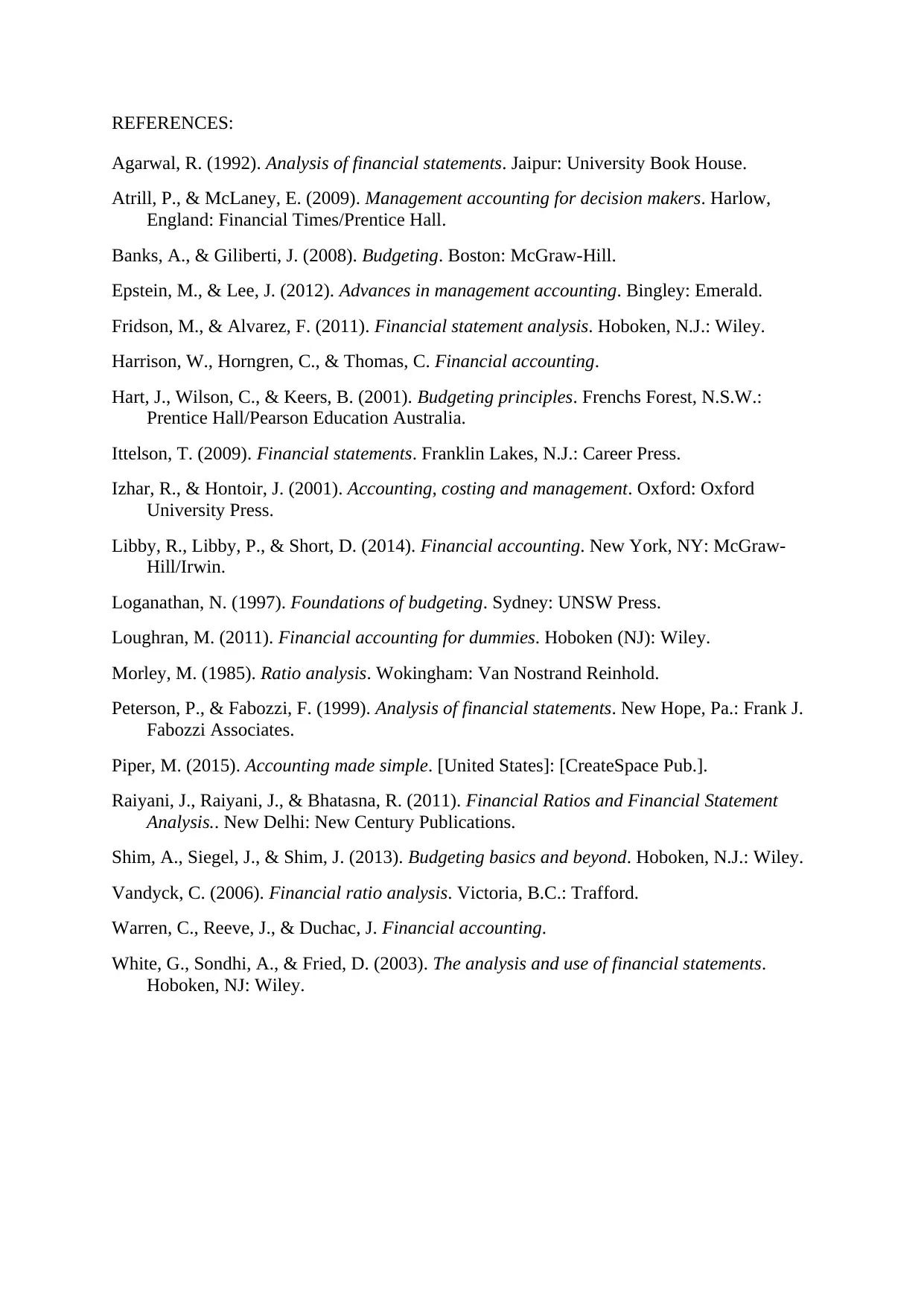
REFERENCES:
Agarwal, R. (1992). Analysis of financial statements. Jaipur: University Book House.
Atrill, P., & McLaney, E. (2009). Management accounting for decision makers. Harlow,
England: Financial Times/Prentice Hall.
Banks, A., & Giliberti, J. (2008). Budgeting. Boston: McGraw-Hill.
Epstein, M., & Lee, J. (2012). Advances in management accounting. Bingley: Emerald.
Fridson, M., & Alvarez, F. (2011). Financial statement analysis. Hoboken, N.J.: Wiley.
Harrison, W., Horngren, C., & Thomas, C. Financial accounting.
Hart, J., Wilson, C., & Keers, B. (2001). Budgeting principles. Frenchs Forest, N.S.W.:
Prentice Hall/Pearson Education Australia.
Ittelson, T. (2009). Financial statements. Franklin Lakes, N.J.: Career Press.
Izhar, R., & Hontoir, J. (2001). Accounting, costing and management. Oxford: Oxford
University Press.
Libby, R., Libby, P., & Short, D. (2014). Financial accounting. New York, NY: McGraw-
Hill/Irwin.
Loganathan, N. (1997). Foundations of budgeting. Sydney: UNSW Press.
Loughran, M. (2011). Financial accounting for dummies. Hoboken (NJ): Wiley.
Morley, M. (1985). Ratio analysis. Wokingham: Van Nostrand Reinhold.
Peterson, P., & Fabozzi, F. (1999). Analysis of financial statements. New Hope, Pa.: Frank J.
Fabozzi Associates.
Piper, M. (2015). Accounting made simple. [United States]: [CreateSpace Pub.].
Raiyani, J., Raiyani, J., & Bhatasna, R. (2011). Financial Ratios and Financial Statement
Analysis.. New Delhi: New Century Publications.
Shim, A., Siegel, J., & Shim, J. (2013). Budgeting basics and beyond. Hoboken, N.J.: Wiley.
Vandyck, C. (2006). Financial ratio analysis. Victoria, B.C.: Trafford.
Warren, C., Reeve, J., & Duchac, J. Financial accounting.
White, G., Sondhi, A., & Fried, D. (2003). The analysis and use of financial statements.
Hoboken, NJ: Wiley.
Agarwal, R. (1992). Analysis of financial statements. Jaipur: University Book House.
Atrill, P., & McLaney, E. (2009). Management accounting for decision makers. Harlow,
England: Financial Times/Prentice Hall.
Banks, A., & Giliberti, J. (2008). Budgeting. Boston: McGraw-Hill.
Epstein, M., & Lee, J. (2012). Advances in management accounting. Bingley: Emerald.
Fridson, M., & Alvarez, F. (2011). Financial statement analysis. Hoboken, N.J.: Wiley.
Harrison, W., Horngren, C., & Thomas, C. Financial accounting.
Hart, J., Wilson, C., & Keers, B. (2001). Budgeting principles. Frenchs Forest, N.S.W.:
Prentice Hall/Pearson Education Australia.
Ittelson, T. (2009). Financial statements. Franklin Lakes, N.J.: Career Press.
Izhar, R., & Hontoir, J. (2001). Accounting, costing and management. Oxford: Oxford
University Press.
Libby, R., Libby, P., & Short, D. (2014). Financial accounting. New York, NY: McGraw-
Hill/Irwin.
Loganathan, N. (1997). Foundations of budgeting. Sydney: UNSW Press.
Loughran, M. (2011). Financial accounting for dummies. Hoboken (NJ): Wiley.
Morley, M. (1985). Ratio analysis. Wokingham: Van Nostrand Reinhold.
Peterson, P., & Fabozzi, F. (1999). Analysis of financial statements. New Hope, Pa.: Frank J.
Fabozzi Associates.
Piper, M. (2015). Accounting made simple. [United States]: [CreateSpace Pub.].
Raiyani, J., Raiyani, J., & Bhatasna, R. (2011). Financial Ratios and Financial Statement
Analysis.. New Delhi: New Century Publications.
Shim, A., Siegel, J., & Shim, J. (2013). Budgeting basics and beyond. Hoboken, N.J.: Wiley.
Vandyck, C. (2006). Financial ratio analysis. Victoria, B.C.: Trafford.
Warren, C., Reeve, J., & Duchac, J. Financial accounting.
White, G., Sondhi, A., & Fried, D. (2003). The analysis and use of financial statements.
Hoboken, NJ: Wiley.
1 out of 7
Related Documents
Your All-in-One AI-Powered Toolkit for Academic Success.
+13062052269
info@desklib.com
Available 24*7 on WhatsApp / Email
![[object Object]](/_next/static/media/star-bottom.7253800d.svg)
Unlock your academic potential
© 2024 | Zucol Services PVT LTD | All rights reserved.




